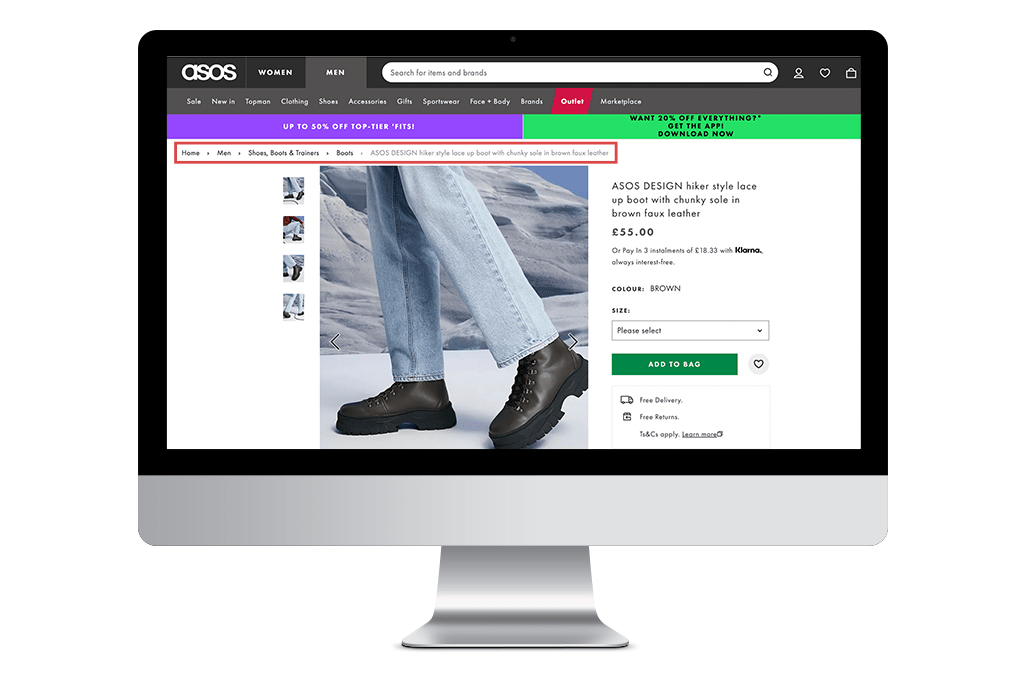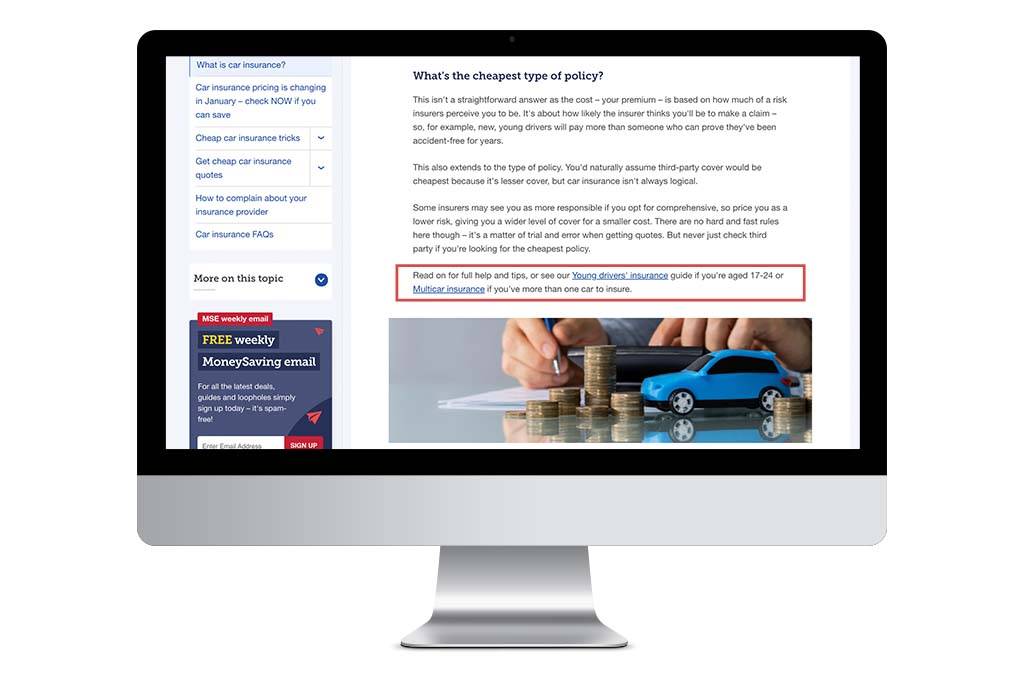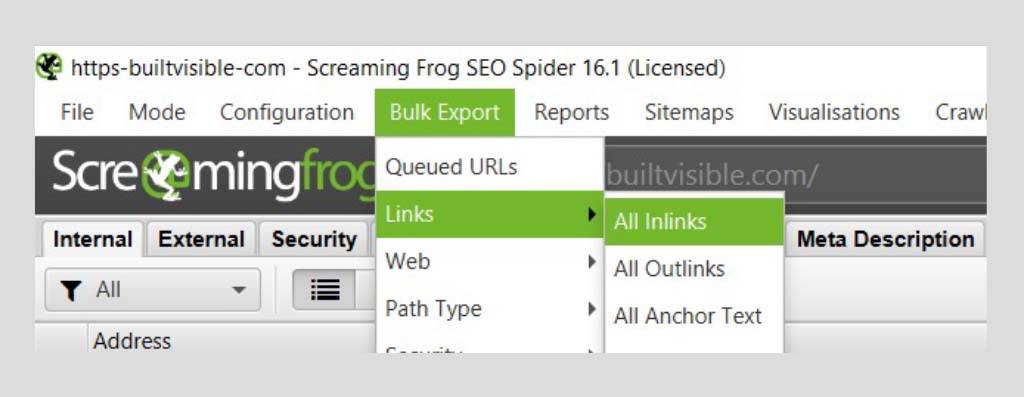1. Keyword & Content Optimisation
Optimising your landing pages for targeted keywords is one of the quickest wins as typically this won’t add any work to your dev team. There are several ways in which you can approach this, to ensure you prioritise resource for the right pages:
Pages with highest return on investment
Start with the landing pages that will have the greatest ROI by selecting the top converters and revenue generators in Google Analytics. You’ll also want to focus on those seasonal pages approaching peak season too.
Low hanging fruit queries
Also, look at queries that currently sit at the bottom of page 1 or top of page 2. These just need that little extra boost to reach more rewarding positions on the SERPs and in some cases, small tweaks such as optimising the H1 or meta title, could be enough to optimise the URL. Others may require larger changes though, such as updating the content structure, so look at prioritising these by level of effort as well as search volume and existing ranking position.
Seasonal pages
If you’ve got dedicated pages for the holiday, such as Black Friday and Cyber Monday or other sales pages approaching peak season, ensure these are optimised ahead of the busy period. When doing that, make sure the seasonal keywords and messaging are included on the page, in relevant places.
2. Internal linking
There are various types of internal links you can add to your site, all of which will contribute to distributing link equity throughout and building contextual relevance between pages. It’s one of the most powerful ways of optimising your landing pages.
Link internally between related products
All the products across your site will share certain characteristics between them e.g. the brand, colour, size, product type… the list goes on. These are called Taxonomies – pages that share relevance, despite sitting within different categories or URL structures on your website. It’s recommended to increase the level of internal links across these types of pages since they tend to be deeper in the site architecture, crawled less frequently and receive less link equity.
Start by selecting a set of your highest revenue generating products and map them to other related products that share taxonomies. Once done, you can start adding internal links between them in the body using keyword rich anchor text. The product description is a good place to start as it can usually be edited manually.
These links will build contextual relevance between the pages and also help users find related products they might be interested in purchasing, increasing your average order value (AOV).
Implement breadcrumb navigation links
(This one may require a dev, but you might be able to implement it without editing your code depending on your set-up so I’ll drop it in anyway).
Breadcrumb links are a great way to build a significant connection between key, relevant pages too – and at scale! By having these types of links, from deep product pages all the way up to their top-level hub page, you’ll build contextual relevance and help Google better understand your page hierarchy.
It also aids the customer journey, by helping users find their way back to category pages and further products if they can’t find what they were originally looking for. This is especially useful when they’ve landed on the wrong page as a result of a content gap, inefficient keyword targeting or cannibalisation issues e.g. a user looking for ‘yellow jackets’ landing on a ‘yellow jacket’ product page rather than a product listing page containing a list of ‘yellow jackets’.

Since breadcrumb navigation links can have a direct positive impact on SEO, you should take advantage! Once you get these in place, make sure you add Breadcrumb Schema Mark up. You can use this schema generator for that and Google’s Rich Results Test to ensure it’s valid.
Exact match anchor text links
These types of links can be very powerful when it comes to keyword targeting as they can help your page rank higher for the targeted query. The keyword used in the link as anchor text should be the main targeted keyword mapped to the destination URL. As an example, Money Saving Expert utilise keyword-rich anchor text to link to their young drivers and multicar insurance pages:

Using the wrong anchor text to link to your pages, such as using a keyword that’s targeted by another URL, can be detrimental as it sends mixed signals to search engines and causes cannibalisation. To audit the state of your anchor texts, run a Screaming Frog crawl and use the ‘links’ bulk exports in the tool. You can also use custom extractions to extract the text from different elements of your page templates and then manipulate the data in excel and run a search through that text for specific mentions of your target keywords. If you’re unsure how, check out the Screaming Frog guide on this.
3. Fix broken links
Internal broken links
Broken link equity is not passed through 404s, so all authority signals are lost and won’t be transferred through internal links to subsequent pages if you’ve got broken links. A good combat then is to run a Screaming Frog crawl and export an ‘All Inlinks’ report, which will show whether there are any internal links on your site pointing to 404s that you can go ahead and fix.

External broken links
Using a backlink analyser such as Ahrefs or Majestic, you can identify if any external inbound links are pointing to 404 pages on your website too. You really don’t want high authority, worthy backlinks pointing to 404s as the value from these links won’t be passed through your site.
As explained earlier, you can either redirect the 404 page (when appropriate) or seek to realign them by reaching out to the referring domain. While this can be a lengthy process, it’s a fruitful exercise and though the benefits of it are unlikely to be seen during the code freeze itself, it’s worth collecting this data to kickstart this process.
You can also use Kerboo to plug in your legacy domains as well as your current domain to ensure you’re building a full and complete list of backlinks. Check out this guide for a more detailed walkthrough of how to realign your backlinks using Kerboo.
4. Update your meta data
Updating your meta data can be a super easy way to improve keyword optimisation and see quick returns. While titles aren’t always respected by Google, it’s recommended you optmise these as they remain an important keyword targeting tool.
Similarly, descriptions aren’t a ranking factor as such but they can increase CTR, leading to an increase in traffic. Including your primary focus keyword within the page title is a great way to tell Google that your page and its content are relevant for that query and bolster that.
First, focus on your high revenue pages and high seasonality pages that will likely bring greater returns during the code freeze and include money phrases that catch the eye of eager buyers searching with transactional intent. You can also drive more clicks to category pages you’ve built to purposefully target holidays such as ‘Black Friday’ and ‘Cyber Monday’ by adding these terms within their meta data.
Another tip is to work with your PPC team to understand what meta data is working and replicate that in the organic channel. A word of warning though – be careful with changing title tags of pages that already include a high-volume priority keyword, as this title is likely aiding your ranking for that query. Make a judgement call and decide whether the ranking position of the query in the title is high enough to warrant keeping.
Tip: You can use a meta data checker to ensure your titles and descriptions fit within the pixel count. To do this at scale, just run it by a Screaming Frog spider crawl.
5. Cull low-quality content
Getting rid of low-quality content has multiple advances for search.
Firstly, depending on the ratio of high vs low-quality content, it ensures a greater level of link equity falls to the high-value pages. Secondly, having large archives of low-value pages such as old blogs or news posts will reduce the discoverability of the higher-value pages as a crawling agent may get stuck in a loop trying to access the low-value pages. By removing these, your crawl budget is utilised more efficiently.
To find these pages on your site, export page click and impression data over the last 16 months from GSC and cross-reference it with a Screaming Frog crawl. Flag any pages that have no clicks, very low impressions and a low level of content. These can either be removed via redirects (if the page has any external links directed to the page) or 410/404-error codes, indicating that it’s removed.
Tip: While reviewing these pages, you may notice opportunities to improve the content on URLs that have low click/impression data but could rank for highly-demanded keywords. Set these pages aside to optimise at a later date!
For more on maximising the crawl efficiency of your website, here are some tips that stand the test of time for optimising faceted navigation.
Get implementing!
As you can see, there’s a wealth of opportunity for improving SEO even during a code freeze, from on-page content edits to off-page link realignment. These can directly lead to increased traffic, higher CTRs and improved revenues i.e. all the crucial metrics for this time of year, so it makes sense to continue efforts in this area and make the most of the upcoming Black Friday and Cyber Monday weekend.
The big holiday season starts in the next two weeks; time is now of the essence so, for extra tips on that, check out the articles below or get in touch.
